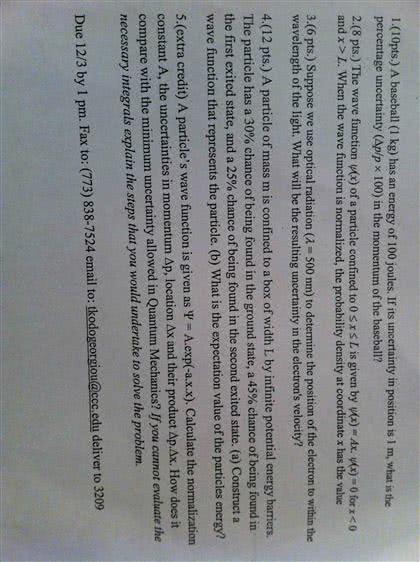PHYS 260 Lecture Notes - Lecture 2: The Principles Of Quantum Mechanics, Matter Wave, Louis De Broglie

PRINCIPLES OF QUANTUM MECHANICS
WAVE & PARTICLE DUALITYOF RADIATION:- To understand the wave and
particle duality, it is necessary to know what is a particle and what is a wave.
1. The concept of particle is easy to grasp. It has mass, it is located at some
definite point, it can move from one place to another it gives energy when
slowed down or stopped. Thus the particle is specified by (i) Mass m (ii)
Velocity V (iii) Momentum P and (iv) Energy E
2. The concept of a wave is a bit more difficult than that of a particle A wave
is spread out over a relatively large region of space it cannot be said to be
located just here and there it is hard to think of mass being associated
with a wave. Actually a wave is nothing but rather a spread out
disturbance. A wave is specified by its (i) Frequency (ii) Wavelength
(iii) Phase of wave velocity (iv) Amplitude and (v) Intensity.
Considering the above facts it appears difficult to accept the conflicting
ideas that radiation has a dual nature i.e. radiation is a wave, which is
spread out over a space and also a particle which is localized at a point in
space – However this acceptance is essential because radiation some times
behaves as a wave and at other items as particle as explained below.
(I) Radiation including visible light infrared, ultraviolet, X-rays etc.
behaves as waves in experiments based on interference diffraction
etc this is duet to the fact that these phenomena require the
presence of two waves at the same position at the same time.
Obviously it is difficult for the two particles to occupy the same
position at the same time, thus we conclude that radiations behave
like waves.
(II) Planck’s quantum theory was successful in explaining black body
radiation. The photoelectric effect, the cooption effect etc eand had
clearly established that the radiant energy in its interaction with
mater behaves as though it consists of corpuscles. Here radiation
interacts with matter in the form of photons or quanta. Thus we
conclude that radiation behaves like particle.

Radiations thus sometimes behave as a wave and at some other time as a
article i.e. it has a wave particle dualism. Here it should be remembered
that radiation can to exhibit its particle and wave properties
simultaneously.
DEBROGLIE HYPOTHESIS
Louis de-Broglie in 1924 extended the wave particle parallelism of optics to all
the fundamental entities of physics such as electrons protons, neutrons, atoms
and molecules etc. de Broglie put a bold suggestion that the correspondence
between wave and particle should not confined only to electromagnetic radiation,
but it should also be valid for material particles i.e. like radiation, matter also
has a dual characteristic. In his thesis he wrote that there was an intimate
connection between waves and corpuscles not only in the case of radiation but
also in the case of matter.
A moving particle has always got a wave associated with it and the particle is
controlled by the wave in a manner similar to that in which a photon is
controlled by waves.
According to de Broglie hypothesis a moving particle is associated with a wave
which is known as de Broglie wave. The wavelength of the matter wave is given
by
λ
== p
h
mv
h
where m is the mass of the material particle. V is the velocity and
P is its momentum.
EXPRESSION FOR DE BROGLIE WAVE LENGTH
The expression of the wavelength associated with a material particle be derived
on the analogy of radiation as follows. Considering the planck’s theory of
radiation the energy of a photon (quantum ) is given by
λ
γ
/hchE
=
=
------(1)
where C is the velocity of light in vacuum and
λ
is its wavelength.
According to Einstein energy –mass relation E=mc
2
-------(2). From equ (1) & (2)
we get
)3(
2
2
−−−−−−−====
mc
h
or
mc
hchc
mc
λλ
λ
Where mc=P (momentum associated with photon)
If we consider the case of a material particle of mass m and moving with a
velocity V i.e. momentum mv then the wavelength associated with the particle is
given by )4(−−−−−−−== p
h
mv
h
λ


